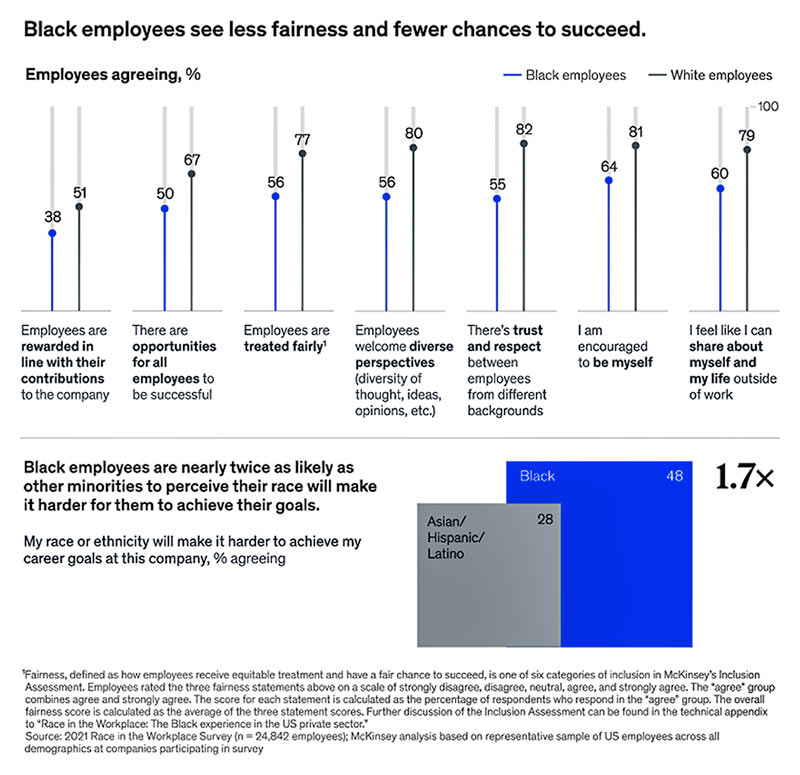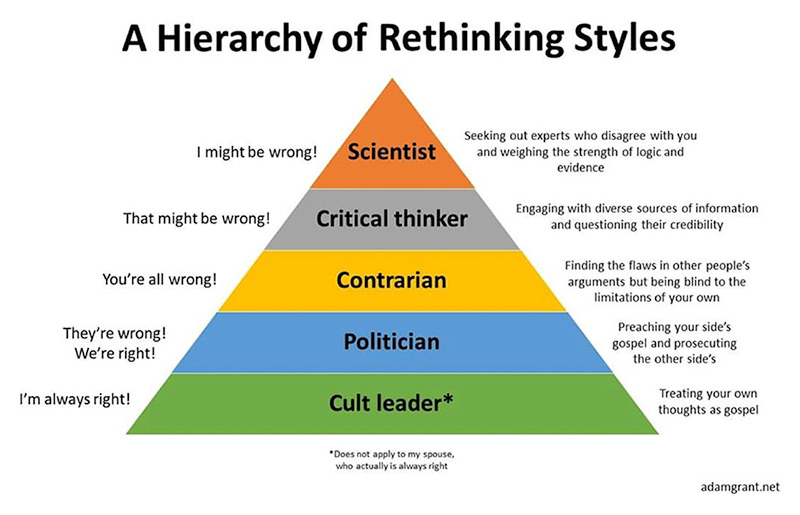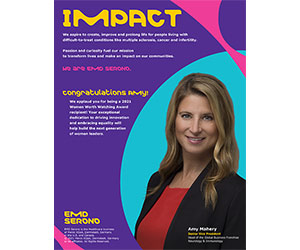By Donald Fan, Senior Director, Global Office of Culture, Diversity, Equity & Inclusion for Walmart

Albert Einstein said, “You can’t use an old map to explore a new world.” While reimaging the post-COVID-19 age, we must remap our ways of thinking and ways of working. Can the future of work create not only economic value but also reflect our social and communal values? Putting equity center stage all the time is an essential component of this new mental model.
Equity is the lifeline for winning the talent war in the upcoming decade, a competitive advantage of thriving in the fourth industrial revolution, and a determining factor to achieve racial and gender justice.
Why
First, more and more organizations realize the crucial role equity plays on many fronts. According to Google Trends, the use of “Equity” shows an upward trend, as users searching business and industrial made the acronym “DEI” 200 percent more popular in the second half of 2020 than it was in the same period five years before.
Secondly, embracing equity is a strategic imperative to catalyze breakthrough growth. Each year, Conference Board conducts a global survey of CEOs to discover what keeps them awake at night. That survey found that business growth in a disruptive world, talent war, and development of next-gen leaders remain the top challenges. Research proves time and again that organizations exercising equity attract and retain high-caliber talent and have a fair chance to compete successfully and win the game.
Internally, these organizations foster a level playing field with an inclusive culture by offering equitable opportunities and access to everyone. They benefit in several ways: Equity empowers cognitive diversity in decision-making and problem-solving. Equity enriches talent experience and engagement. Equity prevents bias, favoritism, and partiality in people decisions, and ultimately, improves talent retention. Externally, equity helps make environmental, social, and governance issues part of the core strategy and demonstrates deliverable value.
Thirdly, practicing equity propels business results through value creation. As stated in a recent Deloitte study, not addressing critical racial inequity is estimated to have cost the U.S. economy $16 trillion over the past two decades. If the gaps were closed today, it is estimated that $5 trillion could be added to U.S. GDP over the next five years alone, including tens and even hundreds of billions more dollars spent on food, housing, apparel, transportation, and entertainment each year.
The study showed that organizations with inclusive cultures are twice as likely to meet or exceed financial targets as those without, three times as likely to be high performing, six times more likely to be innovative and agile, and eight times more likely to achieve better business outcomes.
Finally, equity is truly the capstone of the diversity, equity, inclusion (DEI) journey because it results in a strong sense of trust and engagement. Think it this way. Suppose diversity reflects a seat at the table (individual). In that case, inclusion is a voice at the table (interpersonal), and equity is how you react to the collective voice in practice (institutional). Without equity, you cannot harness the value of diversity and inclusion.
What
Equity simply means fairness and inclusivity by offering everyone an equitable opportunity and access to development, information, resource, and decision-making. Equity hinges on an objective rule-based discipline and trust-oriented culture. It entails removing hurdles such as favoritism, prejudice, xenophobia, and the consequences of these hurdles, such as injustice, disparity, and lack of access to all the things that create a safe and inclusive environment.
As the rhetoric around equity becomes more ubiquitous, equity and equality are often conflated. Equality refers to sameness and equity centers on fairness. In other words, equity focuses on providing people what they need to be successful by addressing disproportionality. In contrast, equality offers everyone the same thing by assuming proportionality, regardless of individualized need. In general, Equity is what happens when all underrepresented employees have equitable opportunities and support to succeed and grow.
You need to be aware of the difference between another pair of terms: systematic inequity and systemic inequity. “Systematic” implies a complete series of steps that you follow. It is explicit, like official policy or process. “Systemic” refers to the system itself. It is implicit, like unofficial practices or unwritten rules. It reflects a quality inherent in the system, not necessarily on purpose, but more that is just the way it works. Systematic inequity is a set of practices that discriminate based on gender, race, ability, and LGBTQ+. Systemic inequity describes a system that has imparity inherent in how it operates.

How
Today’s reality is we have a significant equity gap to close in the workplace. As reported from a recent McKinsey study, black employees experience less fairness and fewer chances to succeed. See the result below:

Inequity is a systemic problem that requires a systemic solution.
An equity strategy aims to level the playing field and ensure all employees feel psychologically safe to bring their whole selves to work. And everyone is offered a fair chance and equitable opportunity to learn, develop, and advance. That effort helps transit from an employee-centered value proposition to a human-centered value proposition that treats employees as people, not workers.
The equity strategy starts with organizational commitment, and leadership with empathy and authenticity. Intentionally revisit the current status and understand what brought you here. That assessment tells you where you want to play and how to win. You then hold people accountable for cultivating and sustaining an inclusive culture and equitable workplace. And you ensure that equity is central to every decision and career moment—from recruiting, hiring, and onboarding, to development, succession planning, and performance evaluation. Finally, communicate your equity narrative to the entire organization and invite everyone along on the journey.
How do you make equity center stage all the time?
According to Fortune/Deloitte’s 2021 CEO Survey, 90 percent of CEOs reported that diversity, equity, and inclusion are strategic and personal priorities. Moreover, 90 percent also said their company aspires to be an industry leader in DEI practices.
In order to build an equitable future, leaders must activate the full breadth of their control and influence across all parts of their organizations and beyond—from relationships to products, services to spend, and governance to external interactions.
Business executives must lead by example to advance equity. They must utilize their commitment and behavior to influence the behavior and performance of others around them, and speak out to cultivate a culture of equity and inclusiveness. C-suite leaders can consider some examples in the workplace:
Chief Executive Officer: Set vision and expectation; establish leadership commitments and hold C-suite leaders accountable for fostering a culture of equity and inclusion; ratify strategic priorities around diversity, equity, and inclusion; and lead with empathy and humanity through example
Chief HR Officer: Define workforce experience strategy to inform talent strategy and processes; design and deliver on financial, physical, mental, and emotional well-being through equitable rewards and other programs; monitor pay equity; lead succession strategy and planning; and enable a culture that embeds and values diversity, equity, and inclusion in all business operations
Chief Diversity, Equity, and Inclusion Officer: Set strategic priorities with board and CEO; collaborate with executive members to enable DEI in all spheres of influence; initiate and promote DEI programs; establish, evolve, and publish diversity analytics; and encourage transparency and accountability on DEI ambitions and results
Chief Technology Officer: Select and deploy technologies to sustain DEI; advocate data-driven decision-making; design and monitor information flow across the organization; consider biases and ethics in technology; and create and assess data analytics
In addition to leadership commitment, equity is formidable in practice because it calls for purposeful design and consistent effort—taking action against systemic bias, racism, and unequal treatment. Without demonstrating how equity works with specific examples in your organization, it is a vacant concept that erodes trust and serves to undercut equity.
Here are some practical examples that integrate equity in each of the crucial career moments:

Recruiting and Hiring–Nurture a broad sourcing pool, and attract underrepresented talent through innovative initiatives and a trusted brand name:
- Cast a broader net by diversifying candidate sources to reach an inclusive talent pool
- Rethink qualifications to attract candidates from nontraditional backgrounds
- Nudge recruiters and hiring managers at key points in the process to increase awareness of potential bias using AI
- Conduct an in-depth analysis of recruiting processes, such as application pool, screening result, interviewing candidates, and selection decision, to reveal potential bias in each step
- Require diverse slots and diverse interview panels to achieve a more equitable selection decision
Onboarding–Involve everyone deliberately to set them up for success and create an enjoyable experience for all in the early days:
- Emphasize equity, inclusion, and employee value proposition during the onboarding experience
- Establish a buddy system, where every new hire is paired with a cultural ambassador to show them the ropes and decrease their learning curve in a new work environment
- Introduce new hires to the ERG groups to engage them with a sense of community
- Create checkpoints to learn and understand new hires’ experiences and needs, and ensure that everyone has a level playing field to start his or her career with your organization.
Learning and Development–Purposefully invest in a robust talent pipeline and strengthen the talent bench of disenfranchised groups by aligning skills, abilities, and competencies with future organizational needs and changing business and talent strategies:
- Offer everyone equitable access to learning and development opportunities, and resources
- Re-skill diverse employees so they can move into jobs that are currently predominantly white or male; implement targeted development programs to teach learning agility and unlock their full potential
- Provide high-performers early access to sponsors to enrich their work experiences, expose them to senior executives, and accelerate their careers
- Incorporate talent development and succession requirements in all people managers’ performance goals
- Upskill employees to thrive in teams and position them to weather inevitable career challenges due to automation and digitalization
Performance Appraisal–Apply a meritocracy system with objective and unbiased standards to raise employee engagement and morale:
- Appraise employee performance and outcome, not appearance and background; communicate and apply an impartial framework and standard for appraisal ranking
- Create a feedback loop to give honest and constructive advice frequently
- Objectively identify “optimal” candidates for promotions and advancement using AI and machine learning
- Measure employees’ perception of belonging, fairness, uniqueness
- Tie DEI results to annual performance reviews and adopt a zero-tolerance policy with regard to harassment, discrimination, bigotry, and other non-inclusive behaviors
Compensation and Rewards–Incentivize all employees with fair pay and benefits based on contribution, competency development, adaptability, and potential:
- Commit to pay equity by reviewing compensation practices and conducting pay equity audits regularly to mitigate pay disparity
- Identify well-being offerings that help establish an emotional connection with employees; make employees’ overall mental, physical, and financial well-being a priority
- Offer inclusion perks and benefits centered around employee needs
- Ensure your employee value proposition speaks to underrepresented talent
Remote Experience–Reshape ways of working to meet the unique needs of an inclusive workforce:
- Break roles down into activities to determine which can be completed under flexible work arrangements tailored to employees’ personal and professional needs
- Identify ways to provide employees with options regarding where and when they can maintain productivity within the team context
- Provide virtual space for a remote team to share; test best practices and learn from peers
- Redesign virtual work and workspace attuned to inclusivity concerns and employee wellbeing, to increase innovation, performance, and morale
By embedding equity into the talent lifecycle, you enrich your employees’ experience; thus, you accelerate their engagement and productivity, and make your team high performing, dynamic, and resilient.
Closing
Fostering a culture of equity and inclusivity requires an evergreen commitment. We all have a pivotal role to play in reimagining the future, reframing the work, challenging the status quo, and transforming long-held beliefs and behaviors. To get there, we need to rethink and de-learn.
Adam Grant introduced the hierarchy of rethinking style in his latest book, Think Again: The Power of Knowing What You Don’t Know, which advocates thinking like a scientist (seeking out experts who disagree with you and weighing the strength of logic and evidence). Thinking like a scientist is a state of mind—having the humility to know what we do not know, embracing the curiosity to find out more, and applying the new learning. That makes you not only willing to hear new points of view but also eager to seek out evidence that contradicts your opinions.

For instance, ask questions like an anthropologist—why people differ in their beliefs and behaviors. Understand the human brain like a neuroscientist—discover people’s ways of thinking, learning patterns, implicit biases; and spot behavior patterns like a social-psychologist—study how people feel, behave, and relate to each other.
We can adopt this scientific way of thinking to enhance equity in our business and talent strategy, and make it a vibrant part of our cultural DNA. With bold and audacious action, we can challenge outdated beliefs, change behaviors, and create a more equitable future.
Equity at Work: Donald Fan
This article is one of a three-part series on the topic of Equity at Work. With the heuristic study, the author aims to answer the fundamental question: Why and how does equity create value in corporate America. The first article, “Four Essential Levers CEOs Can Adopt to Achieve Racial & Gender Equality,” was published in the PDJ’s Fall 2020 issue, to discuss the leadership competencies needed to advance equity. The second piece, “Charting the Path to Equity in the Workplace,” in the PDJ’s 2021 Q1 issue, presents a case study demonstrating how business leaders elevate equity at work. In the third article, “How To Make Equity Center Stage All the Time,” the author further explores how to make systemic changes and integrate equity into business DNA.
Equity at Work

Donald Fan
Donald Fan serves as Senior Director in the Global Office of Culture, Diversity, Equity & Inclusion at Walmart Inc.






